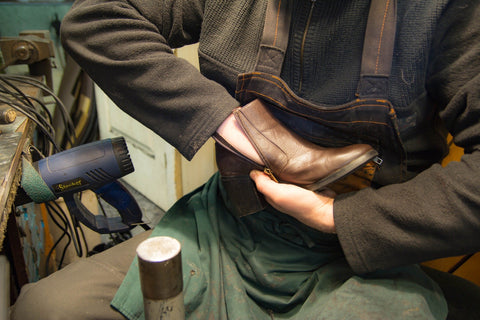A Labor of Love: The Birth of a Shoe
From the Factory Floor to Main & Taylor Shelves

Have you ever wondered how a shoe is made? What goes into making a quality shoe? Why are some shoes more expensive than others? As with any quality product, whether it’s a house, furniture, clothing, or shoes, there is a higher level of design, materials, and production. In this article, we’ll explore these questions and shed some light on how high-quality shoes are made.
At Main and Taylor, we offer some of the best in top-quality shoes. We scrutinize and vet our shoemakers for their processes and workmanship in order to have the “creme de la creme” for our clients. Constructing a shoe is a true craft because of the artisanship that is used just to make one shoe. Making a shoe of the highest quality involves artistry, craftsmanship, and skill as well as a superior material. Luxury designer shoes are handcrafted with painstaking detail and discipline. That’s why you pay more for a shoe that is a quality product.
Many of these shoemakers are families who have been producing high caliber shoes for generations. Our lines like Aquatalia, Coclico, Pedro Garcia, and Brunate are examples of shoes that are designed and constructed with extreme artisanship bearing years of experience and utmost care.
Step 1: Designing the Shoe
Creating the design for the shoe is the very first step in the process. This is where the creative team has a vision for the shoe. Top-notch shoe designers have a combination of creative, commercial, and technical expertise as well as a depth of experience. Most are trained at shoe design schools, but even more important is their work experience and portfolios. They know the classic designs yet they are also artists who have a sense for what looks great.
Step 2: Making the Shoe Last

The second step is creating the shoe last. In order to make a shoe, you must first make and then use a shoe last. The shoe last is a form that is shaped like a human foot from which the shoe’s pattern is created.
In the same way that a high-quality piece of clothing starts with a superior pattern, the highest quality shoe starts with a well-designed and well-constructed shoe last. It gives the shoe its shape. A last ensures that each shoe is consistently the same shape and form.
There is a shoe last for each foot and each size for every shoe. A last must be made of a very strong material because it has to retain its shape as it is subjected to the stresses of stretching and shaping shoes. Shoe lasts are made of a variety of materials like hardwoods, cast iron, and high-density plastics. Check out these shelves of shoe lasts at the Homers shoe factory.
Step 3: Stamping and Sewing

Stamping the shoe materials is the third step in making a shoe. Before the shoe goes into the manufacturing process, the material (for example, high-quality leather) is stamped so that each piece is marked. This eliminates any confusion in the sewing phase. Stamping identifies such features as where eyelets are and perforated accents.
After the materials are stamped, then the pieces are sewn together. The pieces of material are thinned where they are to be sewn so it is easier to attach them.
Step 4: Assembling the Shoe

The next step in making a shoe is assembling the pieces. The shoe is sent to the die assembly department. The more expensive the shoe, the more custom the method for assembling it, even when they are mass-produced.
There are different types of shoe construction depending on the shoe. The process is quite involved and has a very long history, dating back to the mid-1800s. Here you can see the painstaking care that is taken when assembling Gaimo espadrilles.
Step 5: Putting on the Step Insoles and Decoration
After the shoe is assembled, the work turns to the step insoles and decoration for the shoe. Care is taken to attach the insole, the heel, and the outsole so that a shoe is a complete unit.
If there is any ornamental perforation, it is taken care of in this step. Seam holes are hidden through ironing, dyeing, and polishing. The edge of the heel and the outsole are smoothed and other rough aspects of the welt are handled.

Step 6: Finishing the Final Touches
The last step in the production process is what really sets a high-quality shoe apart from a cheaper one. This is where the shoes are polished, laced up, and given a final quality check. Then, they are packaged and shipped to a retailer like us! Take a look at how the finishing touches are put on a pair of Homers boots.
Come Shop With Us!
At Main & Taylor, we offer you shoes with outstanding provenance as described above, as well as more trendy, fun, moderately priced lines. Some of our companies have streamlined their production and can turn to respond quickly to market trends with an eye towards keeping the shoes affordable. You may cherish your works of art but sometimes you just want a cool statement piece that gives you a lot of bang for the buck! With our product lines, you won’t be left in tears if life gets messy and your shoes pay the price.
Come shop with us in one of our retail locations or online to check out our curated selection of styles and designers for every need. You will see what sets us apart!


Leave a comment